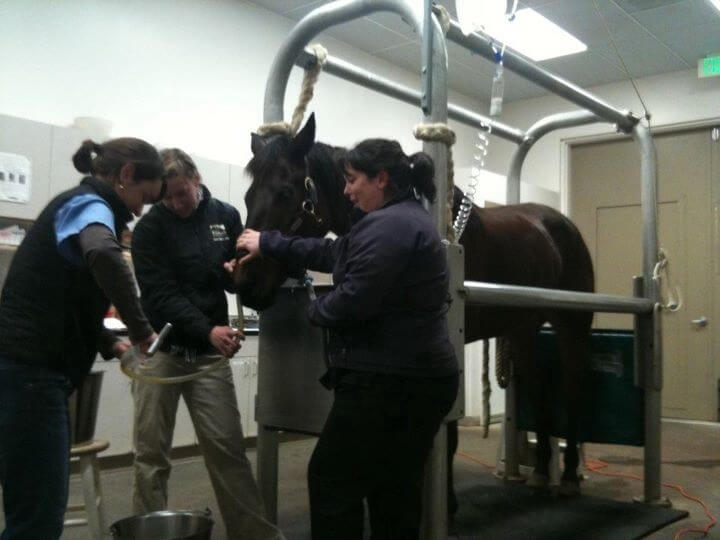An Unusual Colic in a Performance Horse: Part 1
by R. Paul Schwab, DVM
Colic in horses is a stressful situation for owner, horse, and veterinarian. It’s especially difficult on the chronic colic cases where the horse continues to have low grade pain despite passing manure and even eating off and on. Horses have a hard time telling you exactly where it hurts and in these cases we often have to look at more advanced diagnostics such as ultrasound, blood work, and endoscopy to give us the best chance of diagnosing and treating the pain.
I had one of those difficult cases recently on a horse named “Hemi.” You may remember Hemi—a barrel horse—from the January issue. He and his owner were about to embark on a new career in cattle sorting when he started having some low grade discomfort. He just wasn’t quite right for a couple of days then began showing signs of colic one night. Our on call doctor treated him and he seemed to do fine until the next morning when he began exhibiting colicky signs again. He had the classic signs of pawing the ground, looking at his belly, and stretching out his legs to get more comfortable.
One of the first things we discuss with an owner, especially on a colic case we have to treat more than once, is surgery. If surgery is an option for a particular horse we need to make a decision early on so that the surgeons have the best chance at a successful outcome. In Hemi’s case, surgery was an option. As expensive as equine surgery is, Hemi was his owner’s best prospect on the farm. Replacing him would be difficult.

I treated Hemi at the farm and took some blood samples before sending him down to Pilchuck Veterinary Hospital for further diagnostics and monitoring. Basically, if he continued to act colicky, he would be right at the surgical facility if surgery was necessary. In addition, he had the advantage of board certified medicine and surgical doctors to assess his condition. When Hemi arrived, he looked great (at this point I felt like I had sent the owner on a long trip for nothing). They did perform more diagnostics and kept him overnight for observation. His blood work looked good except that his white count and total protein was a little lower than normal. Remember, Hemi had not been quite right for a couple of days. When they performed ultrasound on his abdomen the only unusual finding was that the intestine had increased wall thickness.
For 48 hours Hemi did well. They gave him fluids and monitored his condition carefully, then things fell apart. His protein, which had been slightly decreased at the beginning (around 4.6, normal low is 5.5), dropped down to 3.4! Protein is needed to keep the fluid portion of the blood normal. When the protein decreases, fluid may start to come out of the vessels and collect under the skin or in the abdomen as well as interfere with blood pressure and heart function. Protein is also needed as a building block for muscle and enzyme function. Not only that, but Hemi was still uncomfortable. Where was the protein going and where was the low grade pain coming from?
Unfortunately, exploratory surgery is not a very good option for a horse with that low of protein in the blood. There would be a greater chance of losing the horse from the anesthesia which possibly negates the benefits of surgery. At Pilchuck they were able to keep his blood stabilized using hetastarch, an intravenous product that helps maintain decent blood pressure when a horse has lost so much protein. The decision was made to perform an upper gastrointestinal endoscope exam. They could rule out stomach ulcers as a cause of the pain and protein loss and attempt to take a sample of the duodenum which is the upper part of the small intestine. Fortunately the stomach was in good shape, but they were unable to reach a section of intestine that was damaged. The small intestine of a horse could potentially measure 20 meters in length and an endoscope, at its longest, is only 3 meters. It takes most of that just to get into the stomach.
A presumptive diagnosis of inflammatory bowel disease was made based on the ultrasound appearance of the small intestine, the protein loss, and Hemi’s chronic, low-grade pain. He was started on corticosteroids to decrease the inflammation and put on a low bulk diet to make it easier to pass material through the damaged intestine. At this point the gelding’s prognosis was uncertain.
To be continued…
Published July 2012 Issue

The Northwest Horse Source is an independently owned and operated print and online magazine for horse owners and enthusiasts of all breeds and disciplines in the Pacific Northwest. Our contemporary editorial columns are predominantly written by experts in the region, covering the care, training, keeping and enjoyment of horses, with an eye to the specific concerns in our region.






